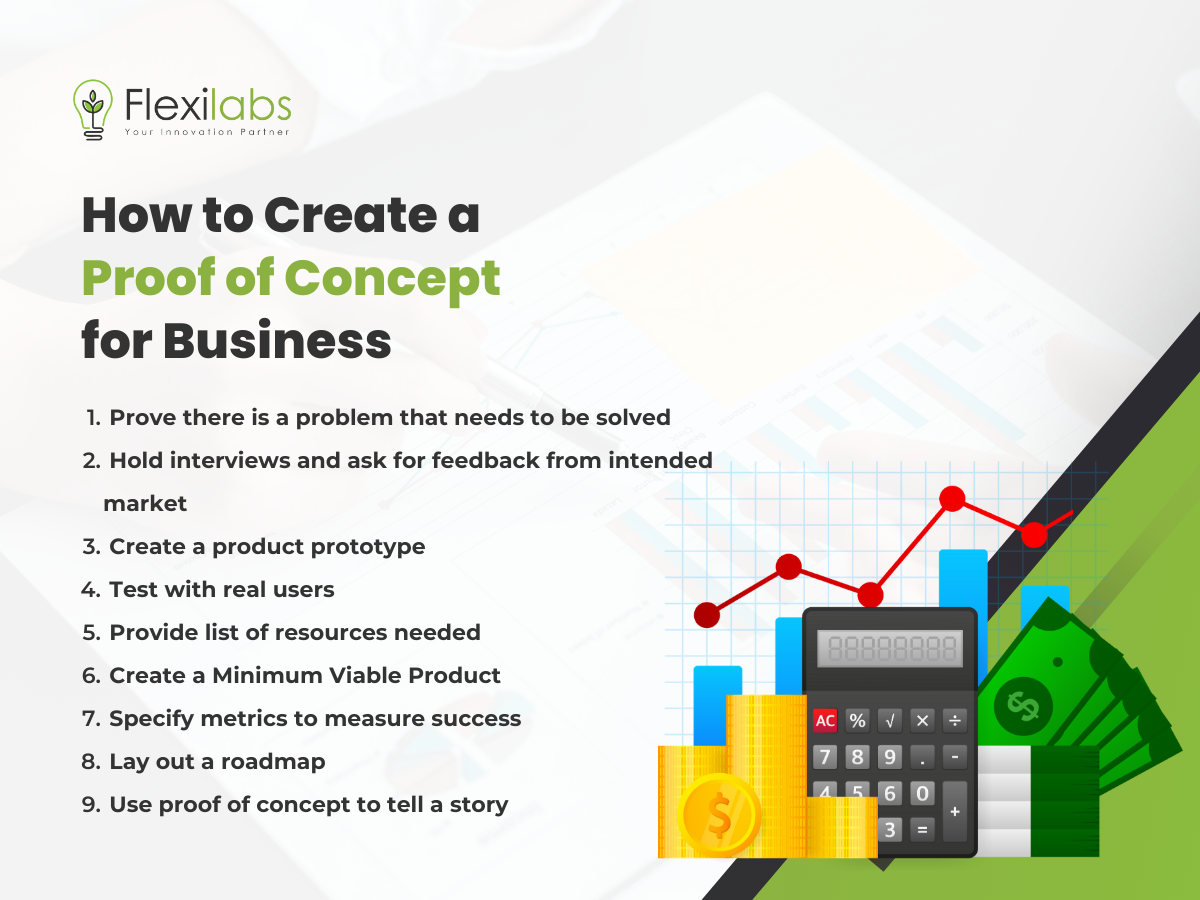Great innovation is not without great planning. As such, turning an idea into a viable business requires a proof of concept. It is a critical step that covers the feasibility of the big idea, provides insights into the market, demonstrates product or service development, and reveals potential risks and opportunities.
With that said, this article is an aid in the early stages for entrepreneurs to achieve business growth by sharing insightful tips on how to develop a proof of concept for a startup.
What is a proof of concept?
As the name suggests, a proof of concept is the stage wherein an entrepreneur tests an idea or concept to determine whether it is feasible and worth pursuing in a business.
The process of starting a business concept paper needs to be thorough. Consequently, it typically involves developing the initial business idea, conducting market research, pinpointing the desired target customers, outlining a business model, and creating an in-depth action plan.
A proof of concept is an important document in the early stages of a business since it provides a clear overview of the proposed business. It can be used to gauge the level of interest from investors and secure much-needed funding.
Benefits of a Proof of Concept for Startup Business
More than an important document, a proof of concept also provides a couple of benefits for the business.
Validates an idea
Proof of concepts for a startup business is crucial since it validates a business idea. It saves time, money, effort and resources down the line instead of jumping into development.
Moreover, a proof of concept answers critical questions, such as: Is there a demand for your business idea? Who are the potential customers? Will it be a good investment?
Explores ways to differentiate a product
It can help entrepreneurs explore ways to differentiate their products. There are proof of concept samples to get ideas from competitors and industry leaders. It can provide insights from customers and further enhance the goods accordingly.
Helps gain investors
Since a proof of concept validates a business idea. Consequently, having the confirmation that the idea can be turned into a business attracts investors along with funding as well.
Resolves issues and obstacles before commitment
It can address any potential issues and obstacles. Since proof of concept helps identify any problems at the very start before anything starts. Business owners can settle these beforehand or prepare for them if they may arise during development or marketing.
Saves money in the long run
It identifies any major adjustments that need to be made for a minimum viable product (MVP). Addressing all potential problems during the early stages makes it easier down the line such as during product development, marketing, and commercialisation.
Tips on Developing Proof of Concept From Real Startups
Good business planning needs a good proof of concept. To do that, here are a couple of tips that actual real startups use to help develop it.
Test the waters with an explainer
An explainer video can be used as a litmus test to see if a solution would pique people’s interest. Moreover, it can be used to attract customers. Make sure to showcase the features and benefits to have a clear idea of a product or service.
Assess demand with a landing page
Another litmus test a startup can do is to create a simple landing page showcasing the product or service to assess the demand and interest of potential customers. This pre-marketing approach can also establish a business’s presence and serve also as part of the proof of concept until a product is developed.

Build demand before building a complete product
To ensure that there is continuous demand, pre-market first to build it up. It generates genuine interest and increases the chances of converting people into paying customers.
This can be done by creating websites, blogs, email marketing, and consistent social media engagement to build the customer base.
Validate a business idea through customer interviews
Another way to help develop a proof of concept is to talk to potential customers. It is a more straightforward approach that helps startups get a better gauge of people’s willingness to pay for a product. A way to do this is by interviewing people within the intended target audience or having them answer survey forms.
Test an idea with crowdfunding
Crowdfunding is another direct approach to evaluate if an idea is viable or a product will sell. Platforms like Kickstarter enable startup businesses to present their ideas directly to the market and give people the opportunity to “pre-pay.”
This tests people’s interest but also determines if they are willing to take out their credit cards and invest real money. Furthermore, this method fulfils two things: One, acts as a proof of concept with the validating of consumer interest. Two, raise capital to build an MVP.
Experiment with a prototype
People often mix up prototypes and proof of concepts, and end up using these interchangeably. However, prototypes are functional versions before the end product. These serve as early versions for raising funds or conducting testing.
With that said, very early prototypes can function as proof of concept, especially for IT companies. This is because the best way to test the feasibility of an idea is to build and test it.
How to Create a Proof of Concept for Business
With that said, here is a guide on how to create your proof of concept for startup businesses.
Prove there is a problem that needs to be solved
The first step in developing a proof of concept is to prove that there is a need or a problem in the market that your idea can address or solve.
You need to gather evidence and data directly from the target market. One way is to leverage online market research tools such as surveys. Another effective way to gather feedback is through social media platforms. At this step, you can validate the need and ensure that it aligns with the customers’ pain points.
Hold interviews and ask for feedback from the intended market
The next step is to directly engage with your target market. Here, it is important to hold interviews and get feedback. You can get valuable insights which will further help you refine your concept.
The point is to understand the target market’s needs, preferences, and challenges. That is why it is important to hold open and honest conversations with people who represent your market to get the best insights.
Create a product prototype
At this stage, you make a preliminary version or model of a product. Here you must design a prototype that you will demonstrate later on. This enables stakeholders to get a tangible sense of the final product along with its functionality, features, and design.
Test with real users
Once you have a prototype, the best way to test it is to have real users that represent your target market try it out and give their honest feedback. This step is where you gather more data and get insights to improve and fine-tune your prototype.
There are various methods such as surveys, interviews, usability tests, or beta testing. Whichever you choose, the point is to select a representative sample of your target audience to conduct a user test effectively.
Provide a list of resources needed
This step is where you compile a thorough list of all the resources you require to successfully launch your new product. Make sure to consider both tangible and intangible resources since these are a form of investment in your business. Aside from materials and machines, remember to pay attention to the time dedicated to research and development and other aspects that require expert knowledge.
Create a Minimum Viable Product
For this step, the goal is to create something that can be quickly developed and launched to gather feedback and validate the concept. Here, you are testing the viability of your business idea in a real-world setting. Moreover, this is where you identify the key features or functionalities of your product.
Keep in mind, your MVP should be user-friendly and intuitive even if it does not have any advanced features or the polish of a fully developed product.
Specify metrics to measure success
With that said, it is essential to establish metrics since these will help you measure success. Moreover, these serve as benchmarks where you can track and evaluate the efficacy and viability of your proof of concept.
When you are specifying metrics, it is vital to base them on your goals and objectives. This is because they provide meaningful insights into aspects of your proof of concept and allow you to gauge its performance more accurately.
Lay out a roadmap
Once you have finalised your MVP and established your metrics, it is time to outline a detailed strategy for bringing your idea to market. For this, you need to research and plan the technical aspects such as manufacturing, logistics, distribution, marketing, sales, and logistics.
This map serves as your action plan to commercialise your product. So, it should be streamlined, optimised, and worth investing in to capture the attention of potential investors.
Use proof of concept to tell a story
The last step is to present your proof of concept to stakeholders, potential investors, or decision-makers. This is the stage wherein you provide them with technical data and financial analysis. More than this, the power of storytelling comes into play to capture their interest and secure support.
It is essential to have a narrative that showcases the value, potential, and impact of your idea. Moreover, this is a better way to connect with your potential investors and help them see the benefits and possibilities of your proof of concept.
Conclusion
Proof of concept is vital to the success of your startup business. It underscores the importance of your business idea since it addresses a problem or needs. It also saves your time and effort later on because it tests the viability of the idea in a real-world setting. In addition, it is also used to attract investors that will help you build your business.
With that said, developing a proof of concept for a startup business requires adaptability, perseverance, and eagerness to continue learning. It is a dynamic process where you will receive plenty of feedback and insight as you go along. The important thing to remember is that when it is done right you will be able to attract the resources and support necessary to turn your business idea into reality.
Let us help you with your proof of concept. Contact Flexilabs now!

